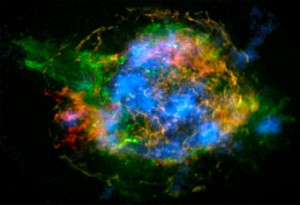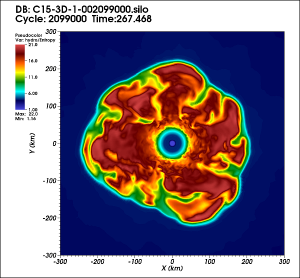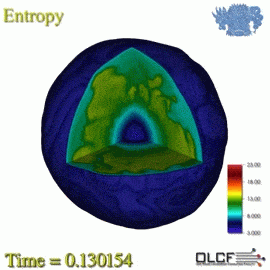It had to be a programming bug, or so researchers thought in 2002, when their computational models found an instability that distorts and drives a shock wave through an exploding star.
But the phenomena, which they called the standing accretion shock instability (SASI), kept showing up.
Now, evidence appears to confirm the phenomenon that John Blondin, Anthony Mezzacappa and Christine DeMarino first described in a 2003 paper. The discovery may answer questions about how we, and everything around us, came into being.
The clue is titanium-44, a radioactive isotope synthesized when atoms merge in core-collapse supernovae – the kind of exploding star the paper focused on.
Titanium-44 is produced in the supernova’s interior, so its location in the remaining fragments provides hints to the blast’s evolution, says Mezzacappa, director of the Joint Institute for Computational Science at Oak Ridge National Laboratory and the University of Tennessee, Knoxville (UT).

In this false-color image, NuSTAR data, which show high-energy X-rays from radioactive material, are colored blue. Lower-energy X-rays from non-radioactive material, imaged previously with NASA’s Chandra X-ray Observatory, are shown in red, yellow and green. Credit: NASA/JPL-Caltech/CXC/SAO.
NASA’s recently launched Nuclear Spectroscopic Telescope Array (NuSTAR) satellite mapped titanium-44 in Cassiopeia A, the remains of a star whose explosive death was sighted around 1671. The space telescope captured high-energy X-rays that emanate as titanium-44 decays into scandium-44 and then calcium-44.
Models that include things like the SASI best explain NuSTAR’s observations, researchers reported in a recent issue of the journal Nature.
The discovery is opposite to how things usually happen, says Blondin, an astrophysics professor at North Carolina State University (NCSU). “In theoretical astrophysics, you rarely get a chance to predict things” for later confirmation. Supernova models have long found the SASI, however, and in the NuSTAR data, “there it is – a very clear picture of it.”
Core-collapse supernovae are explosions of massive stars several times the sun’s size. Over millions of years, tremendous pressure and heat fuse atoms inside these stars into layers of elements, with iron, the heaviest, at the core.
The iron core eventually gets so heavy it collapses. Like a rubber ball that’s squeezed and released, the core rebounds, sending out a shockwave that blasts most of the star material into space. The remaining core becomes a neutron star, comprised of matter so dense a sugar-cube size chunk weighs about 100 million tons.
Ten years later, an international team showed the SASI model probably is right.
Physicists say core-collapse supernovae supply the bulk of the universe’s light elements and many of its heavier ones. Star rubble eventually comprises everything we see around us.
“We’re really talking about the origin of the elements and the origin of life,” says Mezzacappa, who also is on the UT faculty. But understanding the supernova engine is “just a huge problem.”
Early on, researchers found a twist: Matter falling into the core counteracts the rebound shock’s momentum, stalling it for as much as 300 milliseconds – an eternity, considering that the star collapses in about a tenth of a second and rebounds in about a second.
Astrophysicists weren’t sure what restarts the shock, which ultimately powers the explosion. They knew huge numbers of neutrinos – nearly massless particles that constantly pass through us with little effect – played a role. Neutrino heating helps restart the shock, but that process can’t do it alone in spherically symmetric models, in which the shock moves out in all directions. Etc etc etc
Researchers theorized that convection – circulation that pulls neutrinos out of the core and to the surface where they can more easily radiate – distorted and restarted the shock.
In the early 2000s, Blondin says, he and Mezzacappa “jumped into it because in looking at those results, we really didn’t buy” that assertion.
As part of a summer research project, DeMarino and another NCSU undergraduate started building a two-dimensional supernova simulation using the Virginia Hydrodynamics (VH 1) code Blondin had helped create. Hydrodynamics codes portray the physics of moving fluids – in the case of supernovae, gases and particles.
“The whole summer project just failed,” Blondin says, “but the following semester Christine kept working on it and we came up with a very nice, simple model of the supernova shock.”
The model was configured to start convection then stop it. When the researchers ran it on Eagle, Oak Ridge’s IBM SP3 computer, they found some processes kept going, even after convection stopped.
“That’s when we knew something was up,” Mezzacappa says. “We thought it was a bug in the code. But then John came to realize the shock wave itself was unstable – that we had discovered this new instability.”
Mezzacappa explains: If a spherical shock is pushed or pulled evenly from all directions “it’ll just kind of ring down and settle back to its original location.”

This image is a two-dimensional “slice” from a three-dimensional visualization of a core-collapse supernova simulation on Titan, the Cray XK7 supercomputer at Oak Ridge National Laboratory. At this point, about 267 milliseconds after a rebound shock begins to move through the star’s core, the shock radius extends more than 200 kilometers from the center and its shape is distorting. The artificial color tracks the degree of hydrodynamic entropy – or equivalently, temperature – behind the shock. Rising, hot (red) plumes – a signature of convection – are evident. The shock is distorted by this convection and by the standing accretion shock instability (SASI), although the SASI is not yet fully developed. Credit: Eric Lentz, University of Tennessee, Knoxville.
But if the shock is perturbed aspherically – poked or pulled on one side, distorting its round shape – the models showed the distortion keeps growing, even if the initial outside force – perhaps convection, perhaps something else – stops.
“That’s what the SASI looks like,” Mezzacappa says. “The shockwave goes from spherical to being more cigar-shaped, and the fluid [gas and particles] below it is sloshing back and forth further, making it elongate.” In three-dimensional simulations, the distortion is more spherical than elongated but otherwise proceeds similarly.
The growing distortion contributes to neutrino heating, which energizes the final supernova blast, Mezzacappa says.
The team published its conclusions in The Astrophysical Journal in February 2003. Since then, Blondin, Mezzacappa, and their colleagues have continued modeling the SASI in greater detail on successively more powerful machines under DOE Office of Science programs like SciDAC and INCITE. The SASI consistently appears under different conditions and in different models, Mezzacappa says.
The team has pursued the SASI in greater detail on more powerful computers and has used computer visualization to illuminate its simulations. Ten years later, an international team, including scientists from Los Alamos and Lawrence Livermore national laboratories, showed the SASI model probably is right.
This February’s Nature paper, under lead author Brian Grefenstette of the California Institute of Technology, says NuSTAR’s map found titanium-44 distributed through Cassiopeia A in uneven knots. That shouldn’t be so if the explosion went out in all directions. But the knots also aren’t as concentrated as they would be if the star had been rapidly rotating, leading to a blast with matter jetting out from each magnetic pole.
Christopher Fryer, a Los Alamos computational scientist on the Nature team, helped simulate each of those extreme scenarios. The paper says results indicate nonuniform titanium-44 distribution in Cassiopeia A is “far greater than what can be produced by the spherically symmetric explosion” while the bipolar model can’t reproduce the unevenly distributed titanium-44 knots.
“The supernova is better described by an intermediate case,” the paper concludes: a “multimodal” explosion like one including the SASI, or low-mode convection – large-scale matter circulating in the supernova.
Which scenario is right “is a highly debated topic,” Blondin says. The SASI, Mezzacappa says, is “the most natural, simplest explanation.” Blondin agrees low-mode convection is unlikely to produce something like Cassiopeia A, but thinks such instabilities may come into play as the SASI progresses.
The answers may be in highly detailed, three-dimensional models, like the one Blondin, Mezzacappa and colleagues are running on Titan, Oak Ridge’s Cray XK7. At a theoretical peak speed of 27 petaflops (quadrillion calculations per second) Titan is 27,000 times faster than Eagle’s 1 teraflops.
Nonetheless, three-dimensional core-collapse supernova models remain hugely demanding. The Titan project, led by Oak Ridge and UT computational astrophysicist Eric Lentz, has an INCITE grant of a whopping 85 million processor-hours.
“We’re going to chew through that in one model” run, Mezzacappa says. “We’ll probably be begging for more.”

